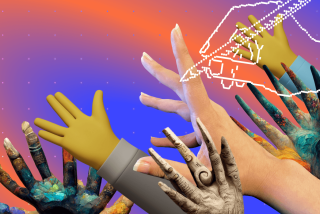American Illustration 4 <i> edited by Edward Booth-Clibborn (Polygon Editions/Abrams: $40; 320 pp., illustrated)</i>
- Share via
The book in question, “American Illustration 4,” a lavishly produced four-color anthology of contemporary approaches to the medium, sets an enviably high standard for the quality of its reproduction and printing. That, and a limited press run, accounts for its imposing price.
Illustration is a funny field. Essentially it uses Fine Art techniques in the service of a pre-existing printed text, whether ad, book, periodical or promotional piece. This book defines it as variations on the representational--expressionistic, surrealistic, cartoonlike, theatrical, posterlike, in a staggering display of technical virtuosity in every imaginable traditional medium--gouache, airbrush, crayon, shading films, acrylic, pastel, pencil, ink, watercolor, scratch board, tempera, collage. You name it.
Some examples stand out. Guy Billout’s mesmerizing visual puns, people in predicaments, set in precise, detailed, and appropriate vacant vistas. Gene Grief’s versions of Herbert Matter on LSD. Walter Bernard and Milton Glaser’s wry, hyperrealistic painting of Karl Marx lighting a cigar with a dollar bill.
But, gradually, doubt enters in. The book (which tends to slide off your knees and onto the floor unless you remain alert) begins to feel heavy. Why? Perhaps it’s the realization that most of what you’re looking at, you’ve seen before, in its original incarnation. Everything reworks the familiar; Jim Buckels evokes Grant Wood and the Emerald City of Oz; Robert Giusti merges Leonardo (including the cracks of age on the surface of the painting) with the Time cover look. Elwood H. Smith clones George Herriman, the legendary ‘40s cartoonist. Steve Carver apes Thomas Hart Benton. Paul Rogers performs a witty rip-off of Soviet constructivism. And so on. The editor, Edward Booth-Clibborn, in his one-page introduction asks the question, “What makes for originality? And what price does it exact?” Exactly.
This retro mood pervades the collection, prompting an additional thought. American commercial illustration used to be one of the very few popular visual forms which set the standards and created the illusions to which we then aspired.
So how come no examples from TV? Film? Computer graphics? How do you define illustration? Well, OK, there’s one image made on a Macintosh, and five scant examples devoted to animation. But, hey, how about David Byrne’s visual concepts for MTV? Or even Bruce McColl’s bravura concept renderings for film?
Answer: The book, like the field itself, is largely an exercise in parochial nostalgia. This represents the conservative taste of the jurors, who in turn may merely reflect our present preference for past forms. In fact, the most contemporary thing about this selection is what it tells us about our current preoccupations. Anxiety, dread and anomie are the darker themes which thread through the more predictable metaphors, visual puns and lyric moods of today, even while clothed in the formal expression of a more optimistic era.
Despite these caveats, “American Illustration 4” is certainly a feast for the eyes and a useful and necessary compendium for the serious student and professional. Who could ask for more than that?
More to Read
Sign up for our Book Club newsletter
Get the latest news, events and more from the Los Angeles Times Book Club, and help us get L.A. reading and talking.
You may occasionally receive promotional content from the Los Angeles Times.









